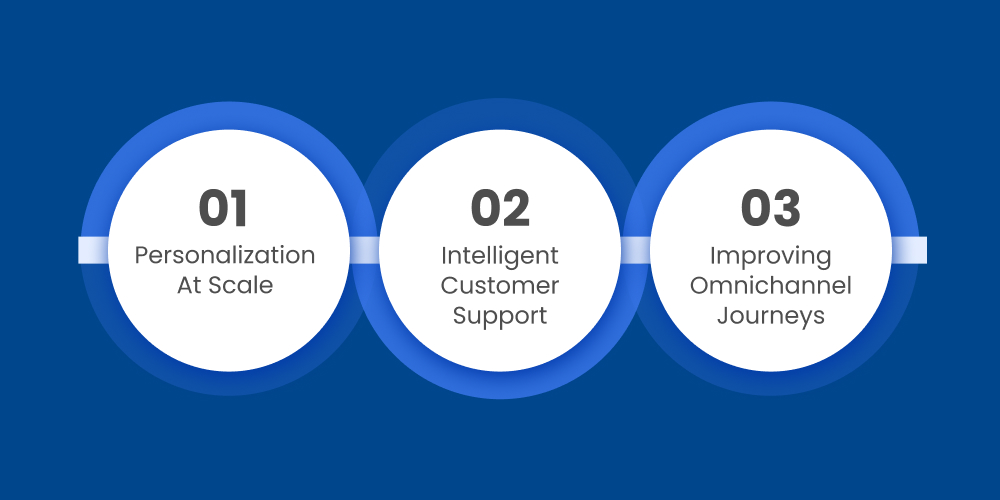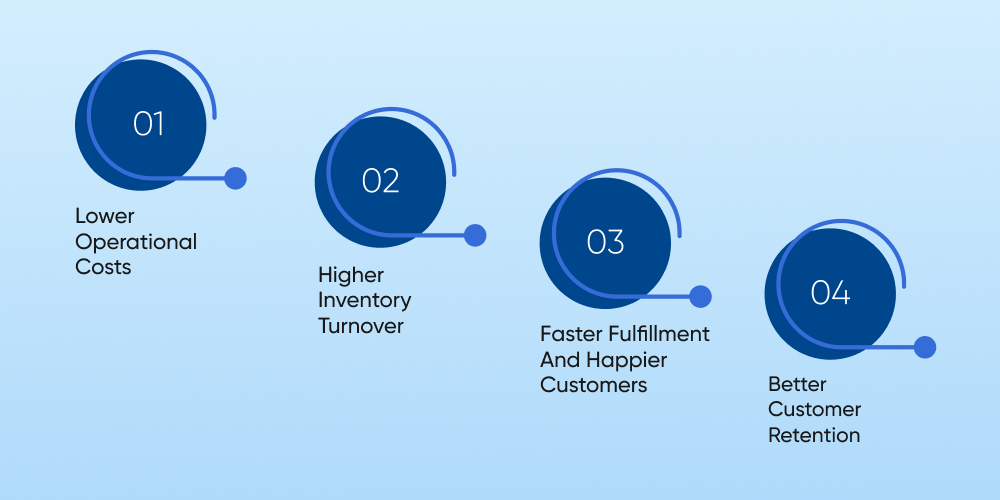How Do AI & Automation Drive Digital Transformation in Retail
Ditstek Blogs
The retail industry has been changing rapidly during the past few years. As markets change and customers become more demanding, even a slight inefficiency can become a significant problem without proper tools and systems in place. This is where digital transformation helps retailers tackle common issues such as lower profit margins, unpredictable buyer behavior, and sales pressure from brands.
Most modern retail stores don’t rely on manual work, but they use automation for every process. They make quick decisions, and they never run out of stock. And it’s all because they use AI and automation tools in their stores.
AI and automation technologies are already helping retailers manage their daily operations. That calming and stabilizing effect is essential, especially when a delayed or out-of-stock item can cause customers to go elsewhere.
Retailers are turning to more intelligent tools that enable them to identify demand earlier, manage costs more effectively, and operate with less uncertainty. This blog shares how AI and automation technologies are transforming the retail industry and helping retail businesses run profitably.
Looking to modernize your retail operations with AI? Connect with DITS for tailored automation and smart retail solutions.
AI Improves Core Retail Operations
As AI is revolutionizing almost every industry in the world, retail businesses are now using AI in their daily operations and processes to save time and resources.
Inventory Accuracy And Real-Time Stock Visibility
Retail businesses often deal with inventory management mistakes that don’t stay hidden. They show up as missed sales, cluttered shelves, or frustrated buyers. AI changes this by tracking patterns that humans might miss or simply don’t have time to notice. AI helps in inventory management by studying past sales, seasonality, sudden spikes, and sometimes even small changes that seem irrelevant at first glance.
AI makes the stock visibility clearer. Teams get alerts before items run too low or too high. This also reduces urgent replenishment runs and overstocks sitting in the warehouse for months.
Smarter Merchandising And Category Planning
Merchandising decisions often come with experience and intuition. AI helps identify product combinations that work well together, spots slow-moving items early, and suggests prices that won’t eat into margins.
Retail planners can rely on insights that highlight which SKUs (stock keeping units) deserve more space and which ones need quicker action. Over time, this improves category performance and helps the entire product mix make more sense. Pretty neat for something running quietly in the background.
Supply Chain Efficiency
Delays in the supply chain hit hard, as nobody likes a late truck or an empty shelf when the product is in demand. AI helps predict demand more accurately, ensuring replenishment days before a product may go out of stock. It connects warehouse activity with store-level movement, making sure the right products move at the right pace.
That smoother coordination reduces bottlenecks and gives businesses an idea of what’s about to come next. And when a company can see ahead, the entire supply chain runs smoothly with fewer surprises.
Automation In Retail Workflows
Retail businesses often face challenges like wasted hours in repeated tasks, understocking, overstocking, poor warehouse management, and back-office tasks, which lead to loss of customers and revenue. However, automation makes things easier by automating tasks and maintaining stock levels to fulfill customer demand at the right time.
Store-Level Automation
Manual shelf checks, repeated tasks, and stock adjustments often slow down things in retail stores, especially during peak times. Automation helps retail stores fix these problems. It assigns tasks automatically, updates shelf data without someone walking aisle to aisle, and keeps routine work from piling up at the wrong moment.
Automation helps retail staff focus on customer-facing work instead of running around handling tiny operational fires. Overall, automation makes the daily operations a lot smoother for retail stores which saves both time and resources.
Back-Office Automation
Back offices in retail stores and warehouses get messy quickly. Vendor emails, approval loops, and reports may take half a day to finish. Together, these slowdowns silently drain the efficiency of day-to-day operations. Automation simplifies these repetitive steps and helps retail stores maintain efficiency.
It creates predictable workflows where documents move automatically, approvals land where they should, and reports are generated without teams losing hours. This is where business workflow automation quietly supports performing daily tasks and helping managers focus on decisions instead of paperwork.
Warehouse And Fulfillment Automation
The volume of orders volumes and customer expectations rise as a business grows. But warehouse capacity may not rise sufficiently to fulfil this demand. Automation helps warehouses place orders automatically, and fulfill the demands of customers, even during peak times. This is done by optimizing delivery routes and tracking the stock in advance.
It’s a clean way to handle omnichannel demand without overwhelming the team. When orders leave on time, it leads to more satisfied customers, even if they never see the warehouse behind the scenes.
AI For Enhanced Customer Experience

AI not only answers queries but speeds up processes, customizes preferences, manages inventory, and offers customer support. Here are some things that AI does for retail businesses to make the processes easier and more efficient, leading to more satisfied customers.
Personalization At Scale
Most retail companies want to personalize experiences, but doing it manually is almost impossible. AI helps spot what customers actually respond to, their browsing habits, past purchases, and timing. It then tailors product suggestions, and offers that feel relevant, and the same are shown to them in the app or website.
And here’s the twist: these personalized moments don’t just help with fast conversions. They make shoppers feel understood, which quietly strengthens loyalty over time. A small change that turns into big payoff with time.
Intelligent Customer Support
Customer queries may arrive at any time. They may arrive early mornings, late nights, or in the middle of promotions. AI-powered support steps in to handle the routine stuff: order status checks, product questions, and simple returns. Teams get relief from the repetitive load, and customers get answers faster.
It’s not replacing human service; it’s making sure staff members aren’t buried under requests that don’t really need manual attention.
Improving Omnichannel Journeys
Retailers running multiple channels know how hard it is to maintain consistency. One missing update in the system and everything feels off: pricing, availability, delivery timelines. AI helps unify these touchpoints by giving a clearer picture of how customers move across channels and what they expect at each step.
Over time, this strengthens the entire shopping journey. Companies like DITS, offering retail software development services often build these AI capabilities into their solutions, so businesses can deliver a smoother, more connected experience.
Ready to improve inventory accuracy, speed up workflows, and enhance customer experience? Talk to our team about building AI-powered retail software.
Decision-Making With AI Analytics For Retail Leaders

Retail leadership today deals with one constant challenge: decisions are getting harder. Markets shift quicker, promotions behave unpredictably, and a product that worked last quarter suddenly loses momentum. AI-driven analytics makes this less chaotic by bringing clarity to decisions.
Faster, Data-Backed Insights
AI brings everything together, sales numbers, customer behavior, stock flows, and even small anomalies that usually go unnoticed. Leaders get dashboards that actually tell a story, not just display numbers. You open it, and within minutes, patterns start emerging.
This is where AI software development becomes extremely valuable for retailers, especially when the tools are tailored to how your business operates instead of forcing you to adapt to rigid systems.
Predictive Intelligence For Planning
Imagine knowing early that a particular category will dip next month, or that a certain product is close to outperforming everything else on the shelf. AI offers that head start. It makes demand planning calmer, reduces last-minute reactions, and makes inventory decisions more predictable.
For retailers seriously pushing digital transformation in retail industry, this level of foresight becomes a strategic advantage.
Retail Risk Reduction
Shrinkage, fraud, and operational leakages drain profits quietly. AI spots unusual patterns and flags them before they grow into real problems. It doesn’t eliminate risk, but it keeps leaders one step ahead, and that’s often enough to protect margins.
At DITS, this is one of the areas where our AI capabilities shine. We use AI in our development workflows; code quality checks, QA automation, and customization, so every analytics tool we build can process data faster, adapt quicker, and learn continuously. Retailers don’t just get software; they get a system that keeps improving with time.
Real-World Business Benefits For Retail Companies

Retailers don’t invest in AI or automation just because these are modern and trending technologies. They do it because the results show up where it matters; margins, speed, and customer satisfaction. And sometimes, the biggest improvements are found in the small, everyday processes that used to slow teams down.
Lower Operational Costs
When repetitive work moves to automated systems, the cost impact becomes noticeable. Fewer errors, fewer manual corrections, and fewer hours wasted on tasks that add no real value. AI and automation allows teams to focus on work that actually drives revenue. Over time, that shift adds up quietly but consistently.
Higher Inventory Turnover
Inventory that sits too long drains cash. AI helps businesses move stock in a healthier cycle by predicting what will sell, when it will sell, and how much to bring in. This leads to cleaner shelves, fewer dead SKUs, and a better grip on working capital.
And all of this feeds into a smoother digital transformation in the retail industry, where decisions aren't reactive anymore.
Faster Fulfillment And Happier Customers
Customers remember delays. They rarely complain about fast service, but slow delivery? That sticks. Automation inside warehouses and order management flows helps cut that lag. Orders move quickly, tracking updates are accurate, and returns get handled with less back-and-forth.
For retailers handling high order volumes, this single shift improves service ratings without any major overhaul on the front end.
Better Customer Retention
AI-driven insights help businesses understand what keeps customers coming back, product patterns, timing, behavior shifts, and loyalty triggers. Instead of blanket promotions, companies start offering value where it truly resonates. And customers feel that difference without anyone pointing it out.
At DITS, this is one of the areas where clients see immediate improvements. Our AI-driven customization ensures every solution learns from real retail behavior, not generic datasets. The result? More accurate recommendations, sharper insights, and ongoing performance improvements baked right into the software.
Challenges Retailers Face During AI & Automation Adoption

Even though AI sounds promising, retailers often run into practical hurdles while trying to put it to work. And the funny thing is, the hurdles rarely come from the technology itself; they come from everything around it.
Data Sitting In Different Places
Most retail businesses have data scattered across POS systems, ERPs, spreadsheets, and outdated tools. AI needs clean, connected information to actually perform well. When systems don’t communicate with each other, teams spend more time fixing data than using insights. It slows projects down before they even begin.
Change Management Issues
People get used to their own ways of working. When new tools come in, not everyone feels ready to shift. Some team members may fear that automation will replace their role, others may worry about learning curves. Retailers have to manage these emotions carefully, not ignore them. If teams don’t adopt the tools, the tools won’t have an impact.
Skill And Training Gaps
AI tools aren’t complicated once they’re set up, but the first few weeks can feel overwhelming. Retailers need clarity on who handles what, who reads insights, and who takes action. Without training, robust systems end up underused, sitting on the sidelines.
Technology Mismatch
Some retailers pick tools that don’t fit their workflow or don’t integrate well with existing systems. Everything looks impressive during a demo, but once implementation begins, gaps start appearing. It’s one of the reasons many businesses prefer solutions that are built specifically for retail operations instead of generic platforms.
At DITS, we noticed this challenge early on. That’s why our team embeds AI during development, QA, and customization, so the systems adjust to the retailer, not the other way around. It cuts down the friction and makes adoption a lot smoother.
Want AI tools that fit your retail workflow, not the other way around? Partner with DITS for customized retail technology solutions.
Getting Started With AI & Automation In Retail
Starting with AI doesn’t have to feel like a massive digital overhaul. In fact, most retailers see better results when they begin small. One workflow. One department. Likewise, one pain point that’s slowing the business down. Fix that first, and momentum builds naturally from there.
Pick A Practical Use Case
Inventory forecasting may be off and reporting may take hours. Or the warehouse is always playing catch-up. Choose the area that hurts the most; that’s usually the easiest place to see quick wins. When teams experience improvements firsthand, adopting new systems becomes far less intimidating.
Review Data And Current Processes
Before implementing any AI-driven tool, retailers need a basic check:
- Is the data clean?
- Is it scattered?
- Are there manual gaps that must be fixed first?
A minor cleanup early on saves months of backtracking later. Without that, even the best AI won’t deliver meaningful insights.
Build A Realistic Roadmap
Some retailers try doing everything at once and end up spreading their teams too thin. A phased roadmap works better. Start with automation, add predictive analytics next, and scale toward more advanced capabilities once the foundation is smooth. Slow but steady wins the race here.
Choose DITS as Technology Partner
A partner who understands retail workflows, not just software, makes implementation simpler. They ask the right questions, spot risks early, and design systems that look like they were built for your company alone.
This is where DITS becomes the right choice for retailers. Our team integrates AI into every part of the build, development, QA, and customization, so retailers get systems that adapt, learn, and keep improving. It’s not just AI or automation software, but a crucial part of the retail business.
Conclusion
Retail isn’t slowing down as it seems from the outside. Every season brings new buying patterns, new demands, and new pressures on margins. AI and automation give retailers a way to handle all of this without burning out teams or relying on guesswork. They quietly strengthen decision-making, speed up routine tasks, and make operations easier and more efficient.
Businesses that start early usually see advantages sooner than they expect. A cleaner inventory cycle, faster order handling, and fewer last-minute surprises. None of it feels significant on day one, but over months, these improvements start shaping how the entire organization works.
DITS continues helping retailers take this step with AI-ready software, tailored automation, and solutions that evolve with the business. Because in a market moving this quickly, stability doesn’t come from holding on to old processes; it comes from building systems that learn, improve, and grow with you.
FAQs
What’s The Role Of AI In Modern Retail Operations?
AI helps retailers spot patterns in sales, customer behavior, and stock movement that are impossible to catch manually. It turns scattered data into clear insights, making planning, forecasting, and daily decisions much easier.
How Does Automation Improve Store And Back-Office Workflows?
Automation removes repetitive work, things like stock updates, reporting, and routine checks. It gives teams more time to handle customer-facing tasks and keeps operations running smoothly even during busy hours.
Do Retailers Need Clean Data Before Implementing AI?
AI works best when the data feeding it is accurate and consistent. A quick data cleanup at the beginning saves a lot of rework later and ensures the insights you get are reliable.
Is AI Adoption Expensive For Mid-Sized Retail Businesses?
Many retailers start with one or two small use cases, forecasting, reporting, or task automation, and expand later. This keeps costs manageable while still showing quick improvements.
How Long Does It Take To See Results From AI And Automation?
Retailers often see early improvements within 4–8 weeks, especially in areas like inventory accuracy or workflow automation. Bigger transformations take longer, but results usually build steadily.
Why Should Retailers Partner With DITS For AI And Automation Solutions?
DITS integrates AI into every part of the development process, from code quality and QA to final customization, so retailers get software that adapts to real business challenges. Our team builds solutions that are practical, reliable, and designed around how retail operations actually work.
Can Existing Retail Systems Connect With New AI Tools?
With the right integration approach, POS, ERP, and warehouse systems can all be connected to modern AI tools. This helps retailers avoid replacing everything at once. Get in touch with DITS for AI integration services in existing system.
Is AI Only Useful For Enterprise Retail Chains?
Smaller and mid-sized retailers often see faster gains because they feel operational pressure more sharply. Even one well-implemented AI project can noticeably improve efficiency.

Dinesh Thakur
21+ years of IT software development experience in different domains like Business Automation, Healthcare, Retail, Workflow automation, Transportation and logistics, Compliance, Risk Mitigation, POS, etc. Hands-on experience in dealing with overseas clients and providing them with an apt solution to their business needs.
Recent Posts
Get in touch



.jpg)






 Calgary | Edmonton | Vancouver | Toronto
Calgary | Edmonton | Vancouver | Toronto